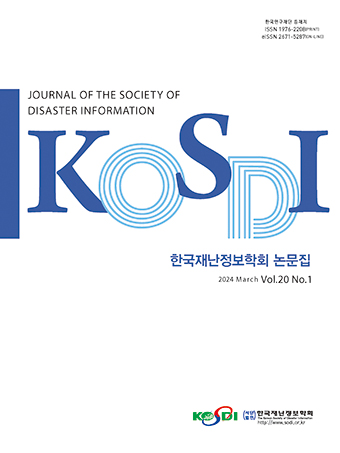Original Article
Abstract
References
Information
Purpose: In this study, GPR exploration equipment, spray vehicles and flow meters, core drill, borehole image processing system(BIPS), 3D cavity imagery equipment, and cavity formatting equipment were used to identify this cavity growth process. Method: A certain amount of water was injected in proportion to the mass of the cavity, and the cavity was observed to expand as the injected water was drained out. The cavity rating change was evaluated by quantitatively evaluating the expansion factors and the speed of growth. Results: According to the results of examining the volume change through injection time - injection flow rate - volume increase for the four experimenters, the volume increase decreased as the injection time increased, and there was no further increase in volume if injected for one hour or so. Conclusion: In addition, the injection test analyzed the volumetric variation to determine whether the cause of the cavity occurrence was the effect of the underground burial in the vicinity of the cavity. Therefore, it was found that the cavity expansion is caused by the repetition of the relaxation soil collapse due to the groundwater flow and the loss of the collapsed soil below the cavity.
연구목적: 본 연구에서는 공동 영역의 변화를 규명하기 위해 GPR 탐사장비, 유량계, 천공기, 공내 촬영장비, 공동 형상화 장비 등을 사용하여 공동 체적에 비례한 일정량의 물을 주입하고, 주입한 물이 빠짐에 따라 확대되는 공동 영역 변화를 정량적으로 평가하였다. 연구방법: 지하수 주입에 의한 공동 체적변화를 살펴보기 위해 실험공 2개소에 대한 주입시간-주입유량-체적증가량을 측정하였다. 연구결과: 주입시간이 증가할수록 체적증가량은 감소하고 있으며 1시간 정도 주입하면 더 이상의 체적증가가 없음을 알 수 있었다. 결론: 주입실험을 통해 체적변화 양상을 분석하여 공동생성의 원인이 주변 지중 매설물에 대한 영향 유무를 판단할 수 있었다. 그리고 지하수 주입 시, 공동이 확장되는 과정에서 주변의 이완된 지반이 일부 붕괴되거나 세립토가 주변 지반의 간극을 채우기 때문이며, 지하수 주입 유량이 증가할수록 체적변화가 증가하는 것으로 미루어, 공동의 확장은 지하수 유동에 큰 영향이 있음을 알 수 있었다.
- Chae, H.Y. (2017). "Study on Subsurface Collapse of Road Surface and Cavity Search in Urban Area", Tunnel & Underground Space, Vol. 27, No. 6, pp. 387-392.
- Cassidy, N.J., Eddies, R., Dods, S. (2011). "Void detection beneath reinforced concrete sections: The practical application of ground penetrating radar and ultrasonic techniques." Journal of Applied Geophysics, Vol. 74, No. 4, pp. 263-273.10.1016/j.jappgeo.2011.06.003
- David, J. Daniels (2005). Ground Penetrating Radar. Encyclopedia of RF and Microwave Engineering. John Willy & Sons, Inc.
- Endres, A.L., Clement, W.P., Rudolph, D.L. (2000). "Ground penetrating radar imaging of an aquifer during a pumping test." Ground Water, Vol. 38, pp. 566-576.10.1111/j.1745-6584.2000.tb00249.x
- Han, Y.S. (2018) "Numerical analysis and exploring of ground condition during groundwater drawdown environment in open-cut type excavation." Journal of the Korean Geotechnical Society, Vol. 34, No. 11, pp. 93-105.
- Hagrey, S.A., Muller, C. (2000). "GPR study of pore water content and salinity in sand." Geophysical Prospecting, Vol. 48, pp. 63-85.10.1046/j.1365-2478.2000.00180.x
- Kang, Y.V., Hsu, H. (2013). "Application of ground penetrating radar to identify shallow cavities in a coastal dyke." Journal of Applied Science and Engineering, Vol. 16, pp. 23-28.
- Kim, B.W., Kim, H.S. (2013). "Estimation of Ground water Table using Ground Penetration Radar (GPR) in a sand tank model and at an alluvial field site." The Journal of Engineering Geology, Vol. 23, pp. 201-216.10.9720/kseg.2013.3.201
- Kim, J.B., You, S.K., Han, J.G., Hong, G.G., Park, J.B. (2017a). "A study on simulation of cavity and relaxation zone using laboratory model test and discrete element method." Journal of Geosynthetics Society, Vol. 16, No. 2, pp. 11-21.
- Kim, Y., Kim, H., Kim, Y., You, S.K., Han, J.G. (2017b). "Experimental study for confirmation of relaxation zone in the underground cavity expansion", Journal of Geosynthetics Society, Vol. 16, No. 4, pp. 231-240.
- Korean Society of Earth and Exploration Geophysicists (2011). Practical Guidelines for Geophysical Exploration, Hanrimwon.
- Lee, K., Kim, D., Park, J.J. (2017). "Study on management system of ground sinking based on underground cavity grade." Journal of Geosynthetics Society, Vol. 16, No. 2, pp. 23-33.
- Park, J.J., Shin, E.C., Park, K.S., Shin, H.S., Hong, K.K. (2018). "An experimental study on detecting materials of GPR for maintenance of restored cavities." Journal of the Society of Disaster Information, Vol. 14, No. 4, pp. 430-439.
- Park, J.J., Shin, E.C., Kim, I.D. (2019). "Field application of RFID for the cavity maintenance of under pavement." Journal of the Society of Disaster Information, Vol. 15, No. 4, pp. 459-468.
- Pyke, K., Eyuboglu, S., Daniels, J.J., Vendl, M. (2008). "A controlled experiment to determine the water table response using ground penetration radar." Journal of Environmental and Engineering Geophysics, Vol. 13, pp. 335-342.10.2113/JEEG13.4.335
- You, S.K., Kim, J.B., Han, J.G., Hong, G.G., Youn, J.M., Lee, K.I. (2017). "A study on simulation of cavity and relaxation zone using finite element method." Journal of Geosynthetics Society, Vol. 16, No. 4, pp. 67-74.
- Publisher :The Korean Society of Disaster Information
- Publisher(Ko) :한국재난정보학회
- Journal Title :Journal of the Society of Disaster Information
- Journal Title(Ko) :한국재난정보학회논문집
- Volume : 16
- No :2
- Pages :267-275
- DOI :https://doi.org/10.15683/kosdi.2020.06.30.267




 Journal of the Society of Disaster Information
Journal of the Society of Disaster Information







